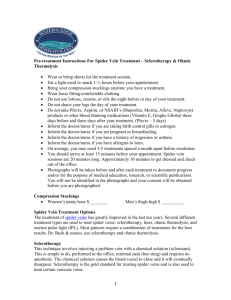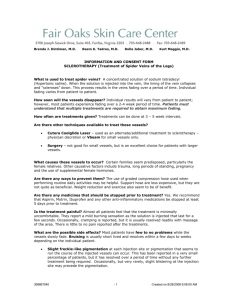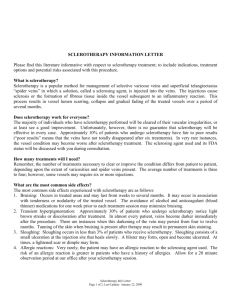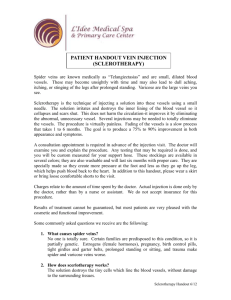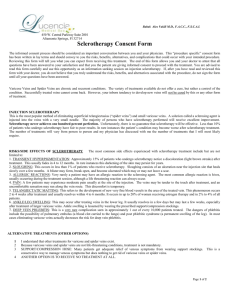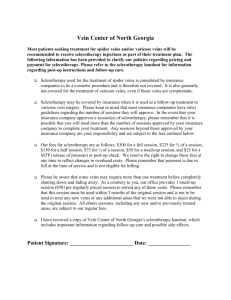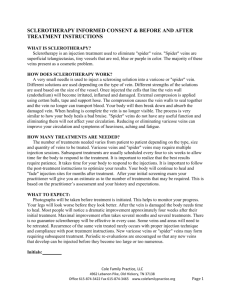VIGILON/SECOND SKIN Wound Dressing
advertisement
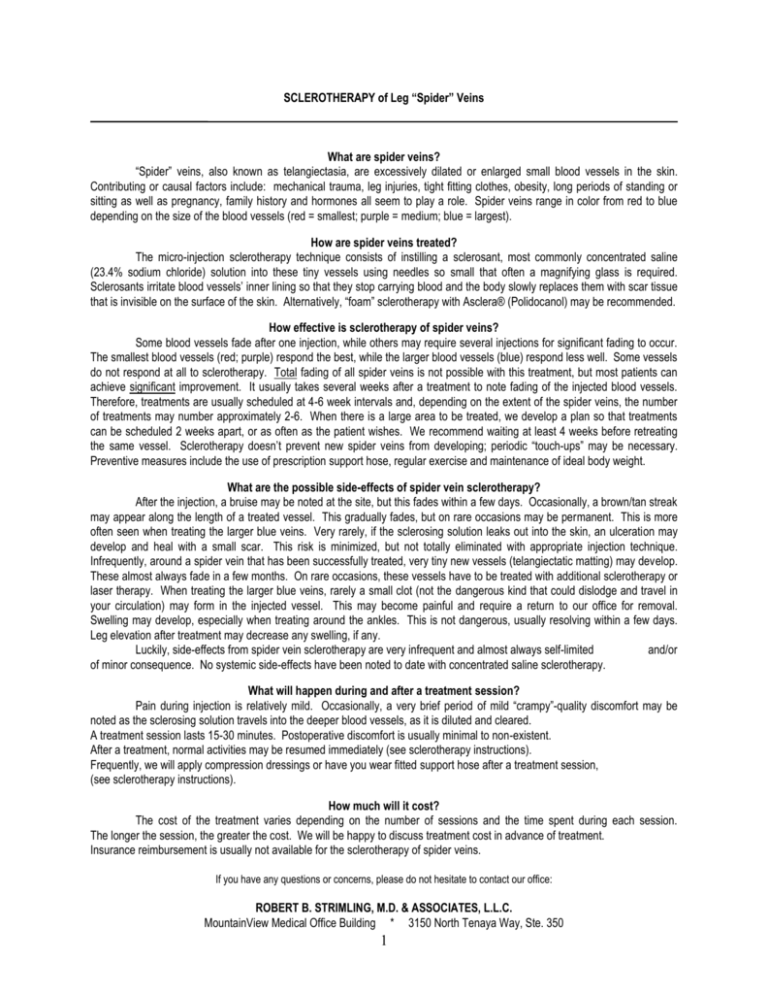
SCLEROTHERAPY of Leg “Spider” Veins What are spider veins? “Spider” veins, also known as telangiectasia, are excessively dilated or enlarged small blood vessels in the skin. Contributing or causal factors include: mechanical trauma, leg injuries, tight fitting clothes, obesity, long periods of standing or sitting as well as pregnancy, family history and hormones all seem to play a role. Spider veins range in color from red to blue depending on the size of the blood vessels (red = smallest; purple = medium; blue = largest). How are spider veins treated? The micro-injection sclerotherapy technique consists of instilling a sclerosant, most commonly concentrated saline (23.4% sodium chloride) solution into these tiny vessels using needles so small that often a magnifying glass is required. Sclerosants irritate blood vessels’ inner lining so that they stop carrying blood and the body slowly replaces them with scar tissue that is invisible on the surface of the skin. Alternatively, “foam” sclerotherapy with Asclera® (Polidocanol) may be recommended. How effective is sclerotherapy of spider veins? Some blood vessels fade after one injection, while others may require several injections for significant fading to occur. The smallest blood vessels (red; purple) respond the best, while the larger blood vessels (blue) respond less well. Some vessels do not respond at all to sclerotherapy. Total fading of all spider veins is not possible with this treatment, but most patients can achieve significant improvement. It usually takes several weeks after a treatment to note fading of the injected blood vessels. Therefore, treatments are usually scheduled at 4-6 week intervals and, depending on the extent of the spider veins, the number of treatments may number approximately 2-6. When there is a large area to be treated, we develop a plan so that treatments can be scheduled 2 weeks apart, or as often as the patient wishes. We recommend waiting at least 4 weeks before retreating the same vessel. Sclerotherapy doesn’t prevent new spider veins from developing; periodic “touch-ups” may be necessary. Preventive measures include the use of prescription support hose, regular exercise and maintenance of ideal body weight. What are the possible side-effects of spider vein sclerotherapy? After the injection, a bruise may be noted at the site, but this fades within a few days. Occasionally, a brown/tan streak may appear along the length of a treated vessel. This gradually fades, but on rare occasions may be permanent. This is more often seen when treating the larger blue veins. Very rarely, if the sclerosing solution leaks out into the skin, an ulceration may develop and heal with a small scar. This risk is minimized, but not totally eliminated with appropriate injection technique. Infrequently, around a spider vein that has been successfully treated, very tiny new vessels (telangiectatic matting) may develop. These almost always fade in a few months. On rare occasions, these vessels have to be treated with additional sclerotherapy or laser therapy. When treating the larger blue veins, rarely a small clot (not the dangerous kind that could dislodge and travel in your circulation) may form in the injected vessel. This may become painful and require a return to our office for removal. Swelling may develop, especially when treating around the ankles. This is not dangerous, usually resolving within a few days. Leg elevation after treatment may decrease any swelling, if any. Luckily, side-effects from spider vein sclerotherapy are very infrequent and almost always self-limited and/or of minor consequence. No systemic side-effects have been noted to date with concentrated saline sclerotherapy. What will happen during and after a treatment session? Pain during injection is relatively mild. Occasionally, a very brief period of mild “crampy”-quality discomfort may be noted as the sclerosing solution travels into the deeper blood vessels, as it is diluted and cleared. A treatment session lasts 15-30 minutes. Postoperative discomfort is usually minimal to non-existent. After a treatment, normal activities may be resumed immediately (see sclerotherapy instructions). Frequently, we will apply compression dressings or have you wear fitted support hose after a treatment session, (see sclerotherapy instructions). How much will it cost? The cost of the treatment varies depending on the number of sessions and the time spent during each session. The longer the session, the greater the cost. We will be happy to discuss treatment cost in advance of treatment. Insurance reimbursement is usually not available for the sclerotherapy of spider veins. If you have any questions or concerns, please do not hesitate to contact our office: ROBERT B. STRIMLING, M.D. & ASSOCIATES, L.L.C. MountainView Medical Office Building * 3150 North Tenaya Way, Ste. 350 1 (702) 243-6400 2 SCLEROTHERAPY INSTRUCTIONS 1. Please do not wear tight fitting clothing on the day of treatment. A full skirt or loose fitting slacks are ideal (for after the treatment). Preferentially, bring shorts or a leotard to wear during the treatment. 2. Preferentially, do not use aspirin, aspirin containing medications or Plavix for at least 1 week before and for 48 hours after treatment. Tylenol is an acceptable alternative if pain medication is needed. 3. Avoid over-heating, prolonged sitting or standing or any strenuous exercise or activity (e.g. aerobics, jogging, stairmaster, or jumping rope) for the first 48 hours after treatment. During this period, short walks are allowed, otherwise try to elevate your legs while sitting. 4. You may return to work at any time after treatment. If your job involves sitting at a desk or standing still for long periods of time, try to get up and take short walks during the first 48 hours after treatment. 5. Speed up recovery after 48 hours by walking or exercising regularly. 6. Before you leave the office, we will wash the treated sites and cover the injection sites with gauze or cotton ball dressings or small Band-Aids, as needed. You may remove these dressings the evening of treatment or the following morning. 7. For maximum results, we recommend medical quality compression hosiery. For best results, wear them continuously for 48 hours immediately after treatment and if instructed so, for as much as possible for 3 weeks after treatment (except for sleep-time after 48 hours). You may remove your support hose to remove any bandages/dressings or for showering before 48 hours, but re-apply them immediately after. 8. You may shower the evening of treatment, (but first remove your compression hose and re-apply them immediately after.) 9. You may swim after 48 hours. 10. To maintain your new beautiful legs for a long as possible, we recommend that you: (i) try to maintain your ideal body weight through healthy diet and exercise, (ii) avoid prolonged periods of standing or sitting, (especially with your legs crossed), and (iii) wear everyday wear support stockings if possible and suitable for your lifestyle. (Ask our nursing staff about our recommended everyday wear support hose.) If you have any questions or concerns, please do not hesitate to contact our office: ROBERT B. STRIMLING, M.D. & ASSOCIATES, L.L.C. Sunrise MountainView Medical Office Building 3150 North Tenaya Way, Ste. 350 (702) 243-6400 3
